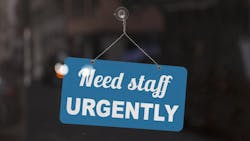The dental hygienist shortage: Will dentistry ever look the same?
Dentistry feels like it’s on the edge of a precipice. Will it change course to avoid it, fall off the cliff, or crash head-on into the rock face? The dental staffing shortage is causing a lot of tension within our industry. Patients are having to wait longer for appointments, offices are luring employees away from other practices, and dental team members are expecting more from their employers.
Just when the world was waking up to the fact that the mouth was connected to the body, a pandemic happened. You’d think this would have been just the boost dentistry needed to break out of the misperception that oral health was a luxury, and if you didn’t have dental insurance, you didn’t go to the dentist. But that’s not what happened. We were quickly relegated as nonessential and sent home.
What no one could have predicted was that many of us wouldn’t come back when offices reopened. For reasons ranging from the fear of infection and family care issues to incompatible practice standards, assistants and hygienists hung up their scrubs. Many went in search of flexible jobs, seeing their neighbors switch from office to home without a hiccup in their paycheck.
So what can dentistry do to attract and keep the talent they need to run successful businesses?
Recognize the change in landscape
If we looked back on the history of dental employees, we’d see women in short white dresses with cute caps supporting the dentist. The entire team was female, and the dentist was male. Since it was a small business, there often weren’t benefits offered, and most of the women were married, so it didn’t matter.
But that is not the landscape anymore. Many of my colleagues are drawn to DSOs or out of dentistry altogether, looking for traditional benefits and annual cost-of-living raises. Or if benefits aren’t a concern, temping has become a tempting way to make more money and call the shots. Talk to anyone in the latest generation, and work-life balance is a mantra.
You might also be interested in: The dental staffing shortage: Insights and strategies
Empower the team as health-care providers
This is dentistry’s moment to embrace being health-care providers. The data is there to support the fact that a strong immune system is what will keep people healthy, and we can’t be healthy if we have an infection in our mouths. Not only do we need to be spreading this message to our patients; supporting this philosophy in practice gives the team a higher sense of purpose—a reason to give it our all.
Ask any seasoned dental professional about the life they saved because they found oral cancer, told a patient about their high blood pressure, or performed perio therapy and the patient’s diabetes was miraculously under control, and you will see passion. Feeling like a spit sucker or a tooth cleaner is not what’s going to keep your team showing up at work.
Make it about more than pay
Recent data from the ADA HPI’s Economic Outlook and Emerging Issues in Dentistry shows that 35% of dentists gave a 4%–6% raise to their employees, and yet 94.5% of them find recruiting a hygienist extremely or very challenging. So clearly, it’s not all about the money.
Everyone wants to love where they work. Dentistry traditionally calls the staff a “team.” But just using the word doesn’t make it so. The 2023 Salary Survey Report from RDH magazine and DentalPost found that 40% of hygienists' top motivators for changing jobs were for a more positive environment or a more appreciative employer. While team building may sound time-consuming or expensive, it’s actually a small price to pay to stop the hiring cycle.
Get your standard of care in order
Coming to work every day knowing that the care you’re providing is the best will not only be reflected in the appointment book but in the team providing it. But providing that level of care requires an investment—of money, time, and trust.
Investing in your team's continued learning through CE courses, proper equipment and supplies, and up-to-date technology is essential to providing that care. Just like a dentist wouldn’t prep a tooth with a dull bur, a hygienist needs effective instruments to perform quality care. The team needs time and supplies to turn a room over properly. And they want to be valued for the knowledge they bring to the practice.
Talk to your team about what they need to do their jobs. That includes not only equipment and supplies but time, education, and collaboration.
Think of all the offices your team drives by to get to yours. Are they hiring?
About the Author

Amanda Hill, BSDH, RDH, CDIPC
Amanda Hill, BSDH, RDH, CDIPC, is an enthusiastic speaker, innovative consultant, and award-winning author who brings over 25 years of clinical dental hygiene and education to dentistry. Recipient of OSAP’s Emerging Infection Control Leader award and an active participant with the advisory board for RDH magazine, DentistryIQ, and OSAP’s Infection Control in Practice Editorial Review Board and membership committee, Amanda (also known as the Waterline Warrior) strives to make topics in dentistry accurate, accessible, and fun. She can be reached at [email protected].


